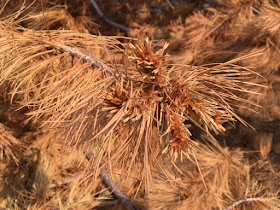Last month I was asked to visit a property to give my
professional opinion as to why a specific Vanderwolf’s pyramidal limber pine
decided to just up and die. A curious problem to be sure. As the story goes,
the tree started to look a little off the 3rd week of July and by
the 3rd week of August all the needles turned completely brown but,
the branches remained limber. When I got to the site I noticed that the ground was nice and moist, possibly a little too wet but not so wet to cause oxygen
starvation in one tree and not the others. I forgot to mention, the dead tree
was one of a group of 6 or 7 Vanderwolf’s all planted in the same area roughly 12 years
ago.
 |
| Stem elongation without full needle expansion "Pushed and Puked" |
 |
| Another view of the arrested development |
I show up on Thursday and the land manager drives up on the
lawn with this huge loader. I ask him why on earth do you have such a big
loader? (You see most landscape contractors use small, light maneuverable skid-steer loaders which are handy and have a million different attachments to
do all kinds of different jobs.) His answer “We do snow removal here too.” Of
course. I assumed he was going to dig up the tree but that was silly; to dig up
the tree would have wrecked a whole lot of irrigation and nobody in their right
mind would want to make more work for themselves. Instead, he wrapped a chain
around the trunk and attached the end to the hook on the bucket and carefully
pulled the tree out of the ground.
Check out the video:
The tree popped out of the ground like plucking a mushroom
from the lawn and we had our answer, circling roots, the result of a missed
step on planting day.
 |
| Circling roots left in the ground after tree removal. |
 |
| Constricted trunk, note the lack of scaffold roots. |
Even Horties Make Mistakes: Tree Planting posted on Monday, August 5, 2013 for more great information about circling roots.

thanks for the visuals. I see this only too often on my tree team visits.
ReplyDeleteIt's very instructive that this sudden death occurred 12 years after the tree was planted; amazing how long it tried to hang on....
ReplyDeleteDo you expect the rest of the trees in the planting group to go the same way?
ReplyDeleteThank you for sharing valuable information. Nice post. I enjoyed reading this post.
ReplyDeleteหนังเกาหลี
Dear Loni,
ReplyDeleteThe land manager and I did inspect the other trees in the group and I believe a few others may also die.
Well done article.
ReplyDeleteBoth article and video are such great training information to have for tree team visits.
ReplyDelete